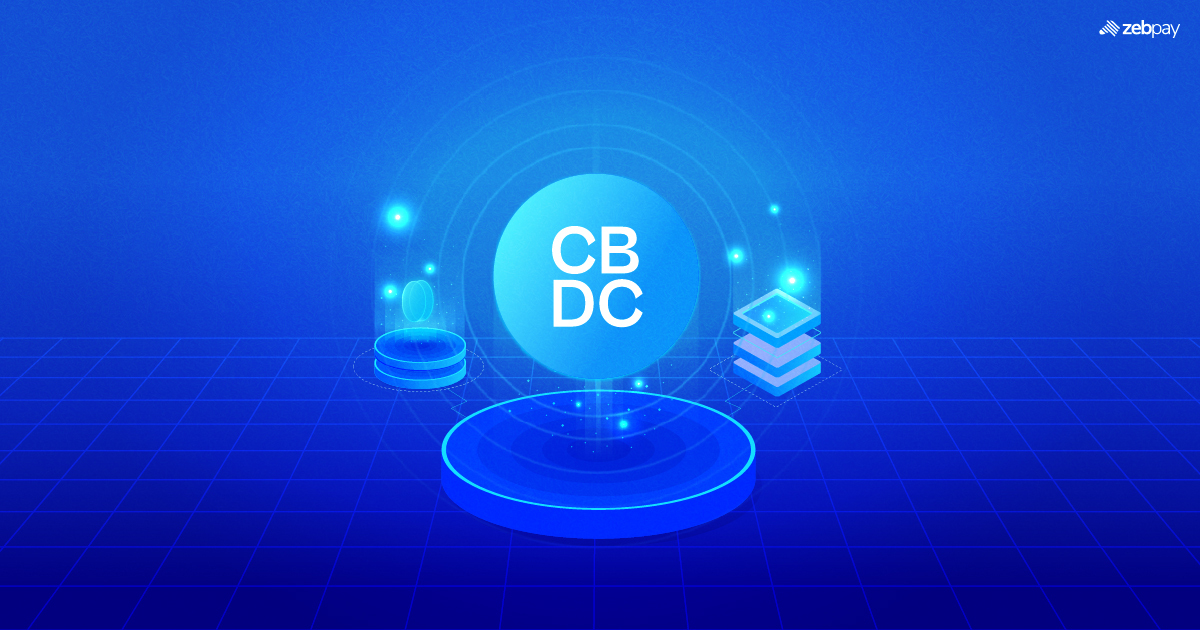What is CBDC?
CBDC stands for Central Bank Digital Currency. It’s a digital form of money issued and regulated by a country’s central bank. Just like the money we use, CBDC can be used to buy things and make payments, but it exists only in electronic form.
Implementing CBDC is an important step for countries because it can bring many benefits and changes to our financial systems. In this article, we will explore what CBDC is, its advantages, and the challenges that must be overcome for its successful implementation.
Understanding CBDC
CBDC is a digital version of our money, like the coins and bills in our wallets. It is created and controlled by the central bank of a country. The central bank is an important institution that oversees a country’s economy and money supply.
Different Types of CBDC
1. General-purpose CBDC
General-purpose CBDC is designed for the general public to use as a digital form of money. It aims to provide individuals, households, and businesses with a convenient and inclusive means of digital payment for everyday transactions.
2. Wholesale CBDC
Wholesale CBDC is restricted for use by banks and financial institutions for interbank transactions. Its primary purpose is settlement and payment processes between banks and other financial entities.
3. Hybrid CBDC
Hybrid CBDC combines features of both general-purpose and wholesale CBDCs. It is designed to serve the needs of both the general public and financial institutions. Hybrid CBDC allows individuals and businesses to use CBDC for everyday transactions, offering the convenience and accessibility of general-purpose CBDC. Simultaneously, it enables banks and financial institutions to access CBDC for interbank settlements.
Advantages and potential benefits of CBDC
- Faster and more convenient payments: CBDC enables instant transactions using smartphones or computers.
- Financial inclusion: CBDC provides access to banking services for people without bank accounts.
- Enhanced security: CBDC incorporates strong security measures to protect money and personal information.
- Improved transparency: CBDC transactions can be tracked and audited, promoting accountability.
- Automation and programmability: Smart contracts and programmable money enable innovative financial functionalities.
- Reduced costs: CBDC eliminates the need for physical cash handling, reducing expenses for printing, storing, and transporting money.
Read more: Pros and Cons of CBDCs
Challenges in Implementing CBDC

Regulatory and legal considerations
Implementing CBDC requires creating new rules and regulations to ensure that it is used safely and responsibly. Governments and central banks need to think about how to protect people’s money, prevent illegal activities, and maintain stability in the financial system.
Technological infrastructure requirements
Building the technology for CBDC is a complex task. It requires a secure and reliable system that can handle a large number of transactions quickly. The infrastructure needs to be able to support the entire country’s needs and ensure that CBDC works smoothly.
Security and privacy concerns
Using digital currency means we need to think about protecting our money and personal information from hackers and fraudsters. It’s important to have strong security measures in place to prevent unauthorized access to CBDC accounts and to ensure our privacy is respected.
Central bank and government coordination challenges
Implementing CBDC requires cooperation and coordination between the central bank and the government. They need to work together to make important decisions and set the right policies for CBDC. Finding the right balance between independence and accountability is essential.
Adoption and acceptance hurdles
For CBDC to be successful, people and businesses need to trust and accept it as a valid form of payment. Some people may be hesitant to switch from physical money to digital currency. It’s important to educate and inform the public about the benefits and safety of CBDC.
Economic and monetary policy implications
Implementing CBDC can have a significant impact on the economy and monetary policies. It’s important to consider how CBDC will affect things like the money supply, interest rates, and financial stability. Central banks need to analyze these implications before implementing CBDC.
Regulatory and Legal Considerations
Central banks and financial institutions play a crucial role in implementing CBDC. They work together to create the rules and regulations that govern its use. These rules ensure that CBDC is used safely and that people’s money is protected. CBDC also needs to comply with anti-money laundering (AML) and Know Your Customer (KYC) regulations to prevent illegal activities.
Technological Infrastructure Requirements
- Blockchain technology and its role in CBDC: Blockchain ensures secure and transparent record-keeping of CBDC transactions, enhancing their integrity and providing real-time validation.
- Scalability and speed requirements: CBDC systems must handle high transaction volumes and process payments quickly to maintain efficiency and provide a seamless user experience.
- Interoperability challenges: CBDC systems need to work together smoothly, enabling seamless transactions between different platforms and participants through the establishment of common standards and protocols.
- Data storage and security considerations: Robust data storage capabilities are necessary to securely handle transactional data, with encryption and protection mechanisms to safeguard users’ sensitive information in CBDC systems.
- Integration with existing payment systems: CBDC implementation should consider integration with existing payment systems to ensure smooth interoperability and minimize disruption.
Security and Privacy Concerns
Using CBDC means we need to think about keeping our money and personal information safe. There are cybersecurity risks, which means that hackers can try to steal our money or personal data. To protect against these risks, strong security measures need to be in place. At the same time, we also need to ensure that our privacy is respected when using CBDC.
Central Bank and Government Coordination Challenges
Some CBDC challenges require collaboration between the central bank and the government. They need to work together to make important decisions and set the right policies. It’s important to find the right balance between the independence of the central bank and accountability to the government. International cooperation and standardization are also important to ensure that CBDC solutions can work across different countries.
Adoption and Acceptance Hurdles
For CBDC to be successful, people need to trust and accept it. Some people may be used to using physical money and may be hesitant to switch to digital currency. It’s important to educate the public about the benefits and safety of CBDC. Addressing concerns and misconceptions can help build trust and encourage acceptance. It’s also important to consider the needs of sectors that heavily rely on cash transactions.
Economic and Monetary Policy Implications
Implementing CBDC can have significant effects on the economy and monetary policies. It’s important to carefully consider these implications before implementing CBDC. CBDC can affect things like the amount of money in circulation, interest rates, and how banks operate. It can also have an impact on cross-border transactions and international trade.
Read more: Role of Central Bank Digital Currencies in Economic Stability
Innovative Solutions for CBDC Implementation
To overcome the challenges of implementing CBDC, there are innovative solutions that can be considered. Hybrid CBDC models and digital wallets can provide flexibility and convenience. Leveraging distributed ledger technology (DLT), like blockchain, can enhance security and transparency. Smart contracts and programmable money can enable new functionalities and automation. Offline functionality can ensure that CBDC can be used even without an internet connection. Interoperability frameworks and partnerships can help CBDC work seamlessly with other digital systems.
Summary and Key Takeaways
Implementing CBDC is a complex process that involves overcoming challenges in regulations, technology, security, coordination, adoption, and policy implications. However, the potential benefits of CBDC, such as faster payments, financial inclusion, and transformative effects on economies, make it an important step for countries to consider. With careful planning, collaboration, and innovative solutions, CBDC can shape the future of our financial systems and bring positive changes to our daily lives.
You can read more about Crypto, Blockchain and Web 3.0 on ZebPay Blogs. Click on the button below and join the millions trading on ZebPay India.
FAQs on CBDC Implementation
What is the difference between CBDC and crypto?
While both CBDC and crypto are forms of digital assets, there are key differences between them. CBDC is issued and regulated by a central bank or government, making it a centralized digital currency. It is typically tied to the country’s official currency and aims to function as a digital equivalent of physical cash. crypto assets, on the other hand, are decentralized and operate on blockchain technology. They are not issued or regulated by a central authority. crypto assets have varying characteristics and use cases beyond being a medium of exchange.
Will CBDC replace traditional banking systems?
CBDC is not intended to replace traditional banking systems entirely. It is designed to complement existing financial infrastructures and payment systems. Traditional banks will continue to play a crucial role in providing various banking services, such as loans, investments, and personalized financial advice. CBDC aims to enhance the efficiency, security, and accessibility of digital transactions, while traditional banks continue to provide a wide range of financial services.
How will CBDC impact monetary policy?
CBDC can have implications for monetary policy. It provides central banks with more direct control and visibility over the flow of money within the economy. CBDC can enable central banks to implement monetary policies more effectively by influencing interest rates, managing money supply, and monitoring transactions in real time. However, the precise impact of CBDC on monetary policy will depend on the specific design, features, and implementation decisions made by the central bank.
What measures are in place to protect against cyber threats in CBDC?
Protecting CBDC against cyber threats is a crucial consideration. To safeguard against cyber threats, robust security measures are implemented. These may include encryption protocols, multi-factor authentication, secure data storage, regular security audits, and collaboration with cybersecurity experts. Additionally, ongoing monitoring, incident response plans, and continuous improvement of security measures help protect CBDC against cyberattacks and unauthorized access.
How can CBDC foster financial inclusion?
CBDC has the potential to foster financial inclusion by providing access to banking services for individuals who are unbanked or underbanked. It can offer a secure and convenient digital payment solution that is accessible via smartphones or other digital devices. CBDC eliminates barriers associated with traditional banking, such as physical branches or minimum balance requirements. By promoting digital financial access, CBDC can empower individuals and businesses, particularly in underserved or remote areas, to participate more fully in the formal economy.
What are the potential risks of CBDC implementation?
CBDC implementation comes with certain risks that need to be carefully addressed. These risks include cybersecurity threats, potential disruptions to the existing financial system, privacy concerns, and potential changes in the dynamics of commercial banks and financial intermediation. Adequate risk management strategies, thorough testing, regulatory frameworks, and collaboration with stakeholders are crucial to mitigate and address these risks effectively.
How will CBDC affect cross-border transactions?
CBDC has the potential to simplify and enhance cross-border transactions. It can enable faster and more efficient international payments by eliminating intermediaries, reducing processing times, and minimizing fees. CBDC can facilitate direct peer-to-peer transactions between individuals or businesses in different countries, enhancing transparency and traceability. However, the implementation and interoperability of CBDC across different jurisdictions need to be carefully coordinated to ensure seamless cross-border transactions.

